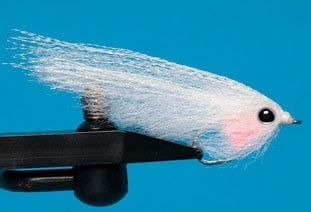
My introduction to luminescent flies was during a New Zealand trip some years ago. The owner of a local fly shop in Rotorua suggested I try night fishing in the small creek mouths that fed the area’s lakes. He explained that big rainbows fed on small minnows there.
When I asked what patterns to use, he handed me some small, unusual white streamers. Cupping my hand and peeking in, I was amazed to see that those little flies lit up like neon. He showed me what they were tied with – a white rubbery material used for skirts on billfish lures. I bought a couple packs thinking the material might be cool to incorporate into some of the flies I tied back home.
Over the next few days, I caught and lost some great rainbows during both night and day on those little glow flies. And ever since, I have been a believer that luminescent flies are not just for night fishing.
Back home in the Florida Everglades, I began experimenting. I came up with a shrimp fly using the New Zealand material. It looked great but was complicated to tie and somewhat hard to cast. The upside was that it really worked on snook and redfish, especially in our tannin-colored waters. I knew I was onto something but had to find a better solution.
Luminescent materials had come a long way since that trip and those early experiments. Flashabou, Krystal Flash, Enrico Puglisi and Uni all offered products that glowed in the dark. Not only did they glow, they were available in different textures and densities, which produced a varying the amount of luminescence.
This combination of texture and luminescence afforded fly tiers myriad possibilities, and before long, I was poling an angler along a shoreline in the Ten Thousand Islands. He was packing a new fly I had tied only a day earlier. I was particularly anxious to try this one.
Just down the shoreline, a dark shape moved slightly on the edge of an oyster bar. My angler made a nice cast, about two feet to the right. He made a short strip, and the snook charged hard. We were connected!
The fly triggered an awesome strike, didn’t spook the fish and solved all the problems of my previous attempts. I called it the Neon Knight, and it’s become my go-to fly in the Everglades.
Easy to tie, it swims great and catches fish. It lands softly and sinks slowly, as the synthetics do not absorb water. It is a favorite not only for skinny-water snook and reds but also for tarpon – they can’t resist the greenish glow it produces in deeper-water situations.
I am not a biologist or scientist, just a fly-fisherman. And I’m a big believer in luminescent flies. They attract fish, period. Enjoy.
Materials
Hook: Gamakatsu, 2/0
Thread: Clear mono, 3/0
Eyes: 3-D asymmetric mirage eyes
Flash: Flashabou, white glow-in-dark
Body & Wing: EP Fiber, white glow-in-the-dark
Throat: Flashabou, pink glow-in-dark
Topping: Krystal Flash, white glow
Tying Instructions
| Step 1: Attach thread midpoint on the hook, and wrap a base to apply a small bunch of EP Fiber. Then add a small bunch of Flashabou directly on top of the EP Fiber. |
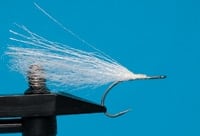
| |Step 2: Turn hook over and tie in a throat of pink Flashabou. Trim just short of hook point. |
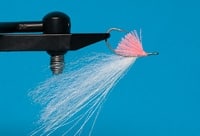
| |Step 3: Wrap thread forward to hook eye for a wing base. Cut a medium-size bunch of EP Fiber and tie them facing forward, with the back end aligned with the throat. Secure by wrapping toward the eye. All fibers for the wing should be forward of the eye.|
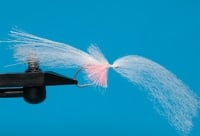
| |Step 4: Pull all the fibers back together and move the thread to the eye. Once all fibers are pulled back, jump the thread on top of the EP Fiber and wrap a tight, neat head.|
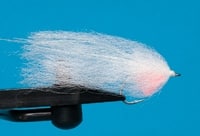
| |Step 5: Add a small bunch of Krystal Flash as topping for the wing. Then trim excess material at an angle, starting at the back and moving toward the hook point. This step is important, as the tapered fibers keep the longer material in back from fouling around the hook.|
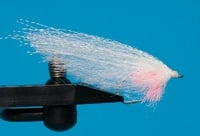
| |Step 6: Secure head and add mirage eyes. You can also add a bit of thinned clear acrylic cement to the entire head to maintain shape.|
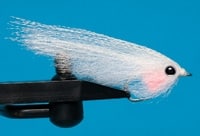
|









